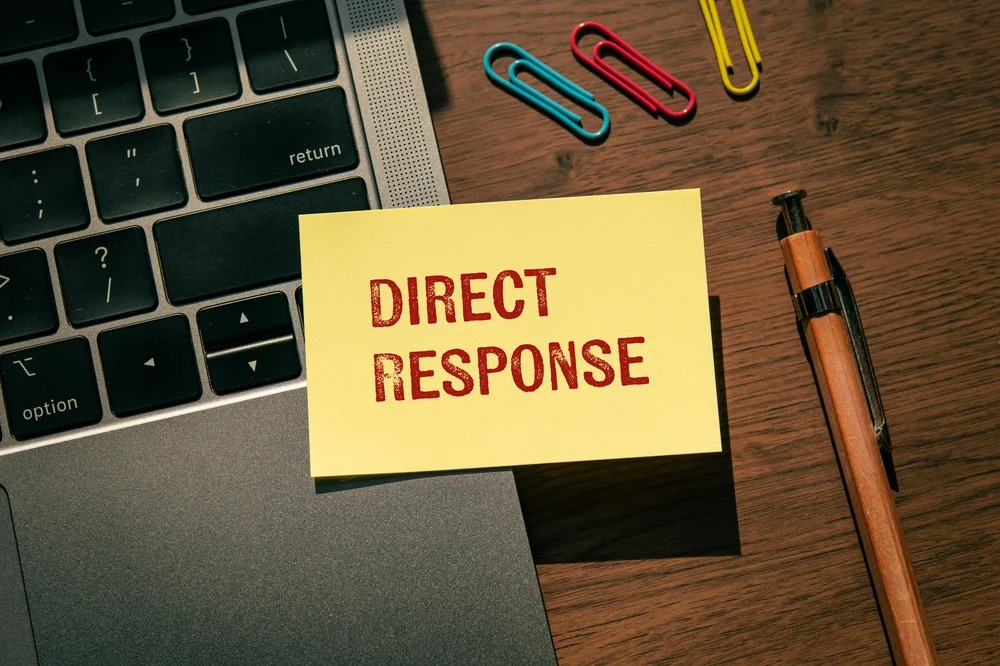Direct Response Marketing: Strategy, Benefits and Example

Direct response marketing is all about getting people to act right now. Instead of just building brand awareness, this strategy is designed to get quick results, like clicking a link, signing up for a newsletter, or making a purchase right away. You’ll often see it used in emails, social media ads, landing pages, and even print ads. The most important element is a clear and direct call to action that tells the audience exactly what to do next.
What makes direct response marketing so effective is that it delivers measurable results. You can track how well your message is working and make changes that actually improve performance. It creates a direct line between your brand and your audience, which helps boost engagement and drive quick sales.
In this guide, we’ll explain how direct response marketing works, why it’s a valuable strategy, and share a real-world example to show how it can deliver results. If you’re looking for fast, trackable outcomes from your marketing efforts, direct response marketing is definitely worth exploring.
What is Direct Response Marketing?
Direct response marketing is a powerful method used to prompt immediate action from potential customers. Rather than simply sharing a message or building brand awareness, it focuses on encouraging quick responses. This could include actions like requesting information, booking a service, or making a purchase. It’s commonly used through online ads, emails, or special offers.
One of its biggest strengths is measurability that you can track how many people responded and make changes based on real-time data. This makes it a practical and results-focused strategy that helps businesses quickly engage their audience and drive meaningful outcomes.
Advantages of Response Focused Marketing
Direct Response Marketing focuses on getting people to take action right away after seeing your message. This type of marketing offers several benefits for businesses:
- Immediate Results: Response-focused marketing asks the audience to take action right away, like calling a number, clicking a link, or making a purchase. This means you can quickly see how well your campaign is working because you get instant feedback.
- Measurable Performance: Since every campaign has a clear call-to-action, it’s easy to track exactly how many people responded. This helps you understand your return on investment (ROI) clearly and make data-driven decisions.
- Targeted Audience: Results-driven marketing lets you focus on specific groups of people who are more likely to be interested in your product or service. This targeted approach reduces wasted spending and increases the chance of conversion.
6 Examples of Direct Response Marketing
Direct response marketing is a type of marketing designed to generate an immediate response or action from the audience. Here are six common examples:
1. Email Marketing: By sending personalized messages directly to customers’ inboxes, email marketing encourages actions like clicking links or making purchases. It provides valuable data on opens and clicks, allowing marketers to analyze engagement and improve future campaigns for better response rates.
2. Social Media Advertising: Social media platforms offer targeted advertising to reach users based on their interests. These ads include strong calls to action that prompt users to visit a website or buy instantly. Tracking clicks and conversions helps marketers refine their targeting and messaging.
3. Direct Mail: Sending physical mail, such as postcards or coupons, to customers provides a tangible way to promote offers. These pieces often include special codes or response cards that allow businesses to track how many recipients acted on the message.
4. Telemarketing: Making direct phone calls to prospects allows businesses to offer products or services and encourage immediate decisions. This personal interaction gives real-time feedback and enables sales teams to adjust their approach, measuring success through appointments or sales made.
5. Infomercials: Extended TV or online commercials educate viewers about products while urging them to act quickly, often with time-limited offers. This combination of detailed information and urgency leads to direct responses, which are tracked via calls or website visits.
6. Online Pay-Per-Click (PPC) Ads: Advertisers use PPC ads to appear in search results or on websites, paying only when users click. These ads lead to landing pages designed for quick actions like sign-ups or purchases, with clicks and conversions tracked for campaign optimization.
What are the Key Components of Direct Response Marketing Campaigns?
Direct response marketing (DRM) is a strategy designed to generate an immediate response from potential customers. Unlike traditional branding efforts that focus on long-term awareness.
DRM aims to prompt instant action, such as making a purchase, signing up for a newsletter, or requesting more information. A successful direct response marketing campaign includes several key components that work together to drive measurable results. Let’s take a look at three crucial parts of direct response marketing ads:
1. An Offer
Every great marketing message starts with a strong offer. It’s what gives people a reason to take action right now. Whether it’s a special discount, a free trial, a bonus gift, or a limited-time deal, a good offer creates excitement and urgency. It should be something your audience actually wants and can understand quickly. For example, saying Get 30% off your first purchase today only! makes the benefit clear and pushes for quick action. A well-made offer focuses on what the customer will gain and why they shouldn’t wait.
2. Information
In direct response marketing, it’s important to give clear and simple information that helps people understand what you’re offering. This includes what the product or service is, how it works, the main benefits, and why it’s useful to them. Good information should support the offer by answering basic questions, solving doubts, and showing why it’s a smart choice. Keep it short and focused, just enough to build trust and interest. For example, listing key features or sharing a customer review can help. The goal is to guide the person smoothly toward taking action, like buying or signing up.
3. CTAs (Calls to Action)
A Call to Action, or CTA, is a short message that tells someone what to do next. It could be something like Shop now, Join today, or Book your slot. The best CTAs are clear, use action words, and often include urgency like Hurry, offer ends soon! This helps people take quick action without second-guessing. CTAs should be easy to spot and placed in key areas throughout your content. When used well, they guide people smoothly from interest to action, making it easier to turn visits into results.
Direct Response Advertising vs Traditional Advertising
Direct Response Advertising and Traditional Advertising differ mainly in their goals, approach, and measurability.
1. Goal and Objective
- Direct Response Advertising: The primary goal is to prompt an immediate action from the audience. This could be making a purchase, filling out a form, calling a phone number, or clicking a link. The success of direct response ads is measured by the number of responses or conversions generated. Every ad includes a clear call-to-action (CTA) such as Buy Now, Call Today, or Sign Up.
- Traditional Advertising: This type is mostly about brand building, creating awareness, and shaping the company’s image over time. It aims to influence consumer perception and long-term loyalty rather than immediate sales. Traditional advertising often includes TV commercials, print ads, billboards, and sponsorships.
2. Message and Communication
- Direct Response Ads use clear, strong messages with specific offers or discounts to prompt quick customer action. They focus on urgency and benefits like Get 20% off today, encouraging immediate purchases. The communication is direct, aiming to drive fast decisions and measurable responses from the audience through persuasive, focused messaging.
- Traditional Ads focus on storytelling and emotional connection rather than urgent sales. They highlight brand values, lifestyle, or product qualities, like comfort or style, without pushing for instant purchase. These ads build long-term brand awareness and loyalty by appealing to feelings and identity, rather than encouraging immediate customer action.
3. Measurability
- Direct Response Advertising is highly measurable because every action, clicks, calls, form submissions, or purchases, can be tracked and linked to the ad. This precise data allows marketers to analyze performance quickly and optimize campaigns in real time for better results and higher return on investment.
- Traditional Advertising has limited measurability. Its success is usually gauged through indirect methods like surveys, brand awareness research, or long-term sales trends. This approach makes it difficult to directly connect outcomes to a specific ad, reducing the ability to quickly adjust marketing strategies based on precise data.
4. Channels
- Direct Response Advertising channels include email marketing campaigns, paid search ads, social media ads with clickable links, direct mail containing response cards, and infomercials featuring phone numbers. These channels are designed to prompt immediate action and measurable responses from the audience, driving direct engagement and conversions.
- Traditional Advertising channels include television, radio broadcasts, newspapers, magazines, and billboards. These channels focus on broad reach and increasing brand visibility rather than prompting immediate audience interaction. They build awareness over time but typically do not track direct consumer responses, serving mainly to maintain brand presence in the market.
Conclusion
If your business is looking for quick and measurable results, direct response marketing is one of the smartest ways to get there. It focuses on clear offers, useful information, and strong calls to action that get people to respond right away. This makes it easier to reach the right audience, track what’s working, and adjust your strategy quickly to get even better results.
Unlike traditional ads that take time to build brand awareness, direct response marketing is all about fast action and real returns. Whether you’re using emails, social media ads, or direct mail, it creates a direct link between you and your customers, boosting engagement and driving more sales.
Need help getting started? Trust Webcazador, we guide you with a clear, results-driven approach that actually works.
Frequently Asked Questions
Effective strategies include email campaigns, paid ads, social media offers, landing pages, and SMS promotions. Each message includes a strong call-to-action to drive immediate engagement. Personalization and urgency help boost conversions. Testing and tracking responses continuously improve performance and ensure the marketing approach stays results-focused.
Services include campaign planning, copywriting, creative design, audience targeting, analytics, and media buying. Companies also offer landing page creation, A/B testing, and performance optimization. Every element is crafted to generate quick customer action. The focus remains on measurable outcomes and driving real-time responses from the audience.
These techniques work well because they prompt instant engagement. Clear messaging, compelling offers, and trackable actions help identify what delivers results. The focus on immediate interaction ensures faster feedback and better control over return on investment. Personalized content also increases response rates and builds stronger customer connections.
Yes, small businesses gain quick visibility, leads, and sales through targeted direct response efforts. With limited budgets, focusing on measurable actions maximizes every dollar. Techniques like email outreach, local ads, or SMS campaigns offer affordable ways to reach specific customers and prompt immediate interaction or purchase.
A direct response system is a marketing approach designed to generate an immediate action from the audience, such as a purchase, sign-up, or inquiry. It uses targeted messages, clear calls-to-action, and measurable channels like email, social media, or landing pages to prompt quick responses and track campaign performance effectively.
Direct response advertising is a type of marketing designed to get an immediate action from the audience, such as making a purchase, signing up, or calling. It includes clear calls to action, measurable results, and often uses formats like emails, social media ads, or infomercials to drive quick responses.




